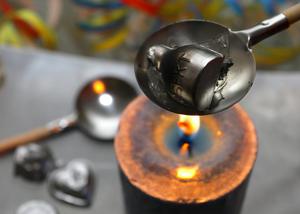
Melting point of tin: properties of the element and its scope
All metals have their own special properties and characteristics. Many of us know from the school curriculum, that each metal has its own melting point. In the thermodynamic process, the crystal lattice in metals is destroyed, and they go from solid to liquidity.
Metals are divided into groups, depending on their melting point - light, medium and refractory. The first group of refractory metals includes tin, but at what temperature this rare chemical element melts, we will try to find out.

Lead
Rare metal tin in the periodic table D. Mendeleev ranks 50th, belongs to the main subgroup of group IV in the table of the fifth period. Its mass is 118,710, in its pure form it looks like a silvery-white metal, soft, plastic and malleable, it has high corrosion resistance. A rare element of distribution in the earth's crust ranks 47th.
The main deposits in the world are in the countries of Southeast Asia - China, Thailand, Malaysia, Indonesia. There are also large deposits in South America and Australia. In Russia, tin ore reserves are in Chukotka, in Khabarovsk and Primorsky Krai, in Yakutia.
A little history
This rare metal became known to people before our era, as it is mentioned in the Bible. He was inaccessible to people, so it was very expensive, tin products are rare among the archeological excavations of ancient Rome and Greece.
It began to be used in the Bronze Age, tin was a strategic metal at the time, as it was a part of bronze products. The recipe for the alloy of copper and tin has survived to this day, but now began to add more aluminum, lead and silicon. The resulting alloy was very hard, perfectly molded, easily forged and processed. At that time, bronze was considered the strongest metal, which was known to the people of that time.
Jewelry was made from this alloy, dishes, but it was very expensive. Many things have been associated with the rare element in the long period of development of society since the discovery of tin.
Properties of tin, its melting point
In nature, a rare metal can be in two forms - in rocks and minerals. The element is most often found in the form of tin stone - an oxide compound. Earlier it was smelted from ore, which was found in the upper layers of the earth's crust. Currently, such minerals have virtually disappeared, therefore, the process of mining tin has become much more complicated.
- Until then, when the metal enters the melting compartment, ore and placers, which contain tin undergo enrichment. After that, the concentrate is sent to the kilns and only then melted.
- The rare element has a low melting point, the melting process begins at + 231,9оС, at temperature + 231,0oC the metal remains solid. Even when cooled, it bends easily, and when heated becomes as pliable as plasticine. The process of boiling tin begins, when the temperature is many times higher than the melting point - 2630oC.
- The element is white and gray, it acquires a darker color, when it turns into a powdery state, in the powder the density of the element is much lower, than when it is in a solid state.
Slag is used in the smelting process, flux, additives for that, to get the right grade and quality of metal. The low melting point made it a strategically important metal. It can easily participate in the formation of alloys with other materials, due to low melting point. In the end, the alloys are easily processed, then they participate in the connection of structural units and parts with a good tight seam.
use of tin
This element is often used as a protective layer in the nuclear industry.
- It is also used in the glass industry as a polishing agent for glass, it is poured in a liquid state into a container with a melt.
- The printing industry uses an alloy of tin with antimony and lead to create a printed font.
- Foil is rolled with tin, element is used in the manufacture of pipes and various parts, to give them corrosion resistance, because tin does not rust.
- The rare element conducts heat perfectly, example, it is often used in the production of cans. In such containers you can store food for a long time, because tin is a non-toxic element. Dishes for a long period of time are not destroyed.
- It is also used in the weaving industry, but only metal salts. It is mainly used in the production of natural silk and for printing on calico fabric.
- The element is also used in medicine, example, in dentistry for reinforcement of some types of fillings. Rare metal is even in the human body, its deficiency can negatively affect growth, for this reason it begins to slow down.
conclusion
Today, tin is used in many industries, because the metal has a number of unique properties. Millennia later, a rare chemical element is still in demand as in its pure form, and in alloys with other metals.




